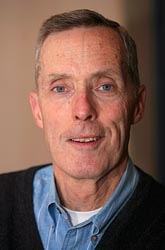If we think we live in demanding times now, look back at events in our lifetime. Some may drift into history and then provide comfort.
Nuclear War and Civil Rights are two events that come to mind. In each, the church had a role with thoughtful teachings on the issues speaking to the moral questions involved.
In the mid-1950s, if the United States were attacked, it was their policy to destroy the Soviet Union and China in a single blow.
The U.S. would fire its entire strategic arsenal of 3,500 nuclear weapons. President Eisenhower did not want to operate under the illusion that there could be a “limited” Nuclear War. The choice — all or nothing at all — was his policy, according to Evan Thomas in his recent book, “Ike’s Bluff: President Eisenhower’s Secret Battle to Save the World.”
This led to some chilling prospects. The plan was “overkill,” said George Kistiakowsky, the president’s science adviser. It would “kill four or five times over somebody who is already dead.” He explained massive attacks “would make the rubble bounce.”
According to Thomas, Eisenhower told no one, not even his family, if he would ever employ these weapons of mass destruction.
Fortunately, the policies of multiple deaths and bouncing rubble are gone. However, it was real at the time. The church had something to say about it.
This year, while watching the presidential inauguration, one could not help being struck by the irony of the separation by two miles and 50 years. Two miles is the distance from the steps of the U.S. Capitol to the steps of the Lincoln Memorial.
Fifty years ago, from the Lincoln Memorial, the Rev. Martin Luther King Jr. faced a crowd of several hundred thousand on the National Mall. As the Capitol dome loomed in the background, he delivered his “I Have a Dream” speech.”
King’s dream, one of a just society, would result — in less than 50 years — in another black man taking the oath of office for a second term as president of the U.S. That man, Barack Obama, stood on the U.S. Capitol steps facing hundreds of thousands of people with the Lincoln Memorial as a backdrop.
During those 50 years, there were racial riots throughout the United States: bitter battles in the halls of Congress, state legislatures, the passage of the Civil Rights Act of 1964, and the Voting Rights Act of 1965.
Nuclear weapon proliferation and racial inequality were major issues in their time. It was difficult to imagine that a solution would be found.
The issues we face now are proliferation of weapons — not nuclear but handguns — immigration reform, climate change.
All will be discussed and debated in the next four years. It is good that we have Catholic teaching to inform consciences and contribute to policy debate.
The teaching authority of the church is respected, even by nonmembers, as having something to say on these and other issues.
“The Challenge of Peace: God’s Promise and Our Response,” a 1983 pastoral letter issued by U.S. bishops, said the nuclear threat transcends religious, cultural and national boundaries. It said initiation of nuclear war is not morally justifiable.
When immigration policy is on the agenda, our faith reminds us that “we are also called to welcome the stranger, to combat discrimination, to pursue peace.”
Stewardship of the environment is to protect God’s creation.
Our grandchildren are amazed today when we tell them there was a time when black people could not attend schools, nor eat in the same restaurants as white people; when backyards were excavated to seek shelter from a nuclear blast.
May of their children would be equally amazed to learn there once was a time when children feared for their lives in classrooms, and when motor vehicles spewed tons of carbon dioxide into the atmosphere.
***
Kent is the retired editor of archdiocesan newspapers in Omaha and Seattle. Contact him at: considers@gmail.com.
PREVIOUS: National unity can emerge from national difference
NEXT: Finding the good news in the news




Share this story